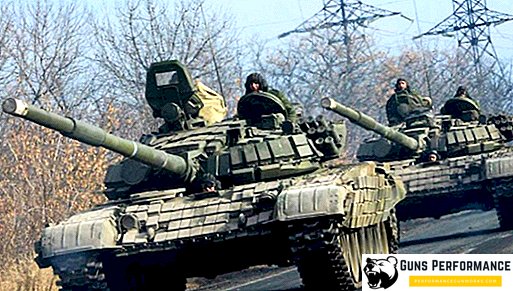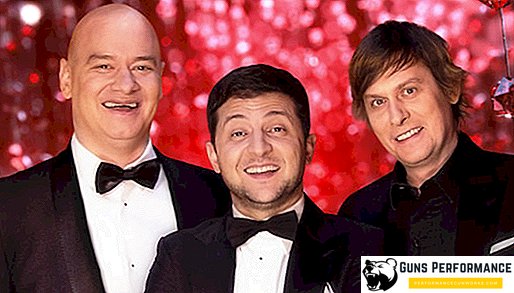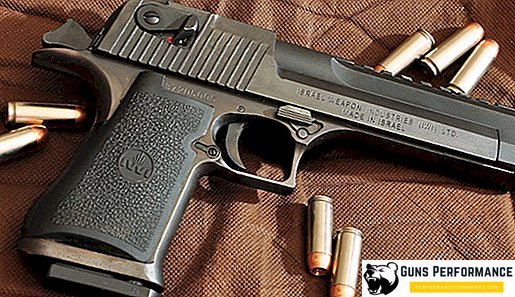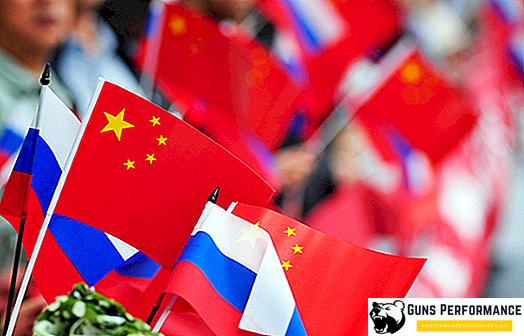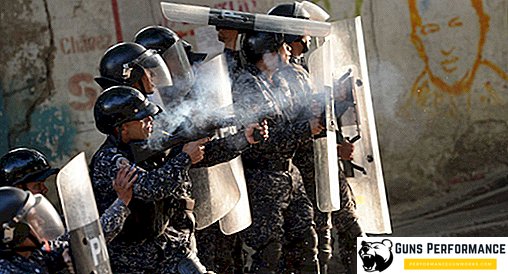
Not so long ago, another Hollywood military blockbuster "Rage" with Brad Pitt, who played a cool tank sergeant, went out to the world film distribution center. The film turned out to be rather ambiguous and caused a lot of discussions, but the daily work of the tank crew is shown in it quite well. However, the main role in this picture was played not by Pitt, but by the famous American tank M4 “Sherman”, which in the film has its own name Fury - “Rage”.
The M4 Sherman was the main medium tank of the American army during the Second World War. The tank got its name in honor of the American General William Sherman.
In addition to the US armed forces, this combat vehicle was supplied to American allies: Great Britain, the USSR, Australia, and Canada. After the end of the war, the Shermans were in service with Israel, Pakistan, Italy, France, India, Japan and Yugoslavia.
In the framework of the Lend-Lease program, the USSR received more than 4,000 Sherman tanks. Soviet tank crews called this war machine "emcha" (from the designation M4) and loved it. To get to serve the American tank was considered luck. The convenience of the crews favorably distinguished the M4 from any Soviet cars. Also, the Soviet tankmen noted the high level of manufacturing of the Shermans, the excellent quality of the instruments and the powerful walkie-talkie. The equipment of each American tank included a coffee maker; this fact invariably made a powerful impression on the Soviet fighters.

Beginning in 1943, the Sherman became the main tank that came from the US under Lend-Lease. In significant quantities, this combat vehicle was also supplied to the UK.
Tank "Sherman" began its combat path in North Africa, then the Allies landed in Normandy and fighting in Europe. The Americans used the M4 in the Pacific theater of war.

And after the end of world war, the service of this combat vehicle continued. "Sherman" was in service with the US Army until the end of the 50s, took part in the Korean War, where he "clashed" with the Soviet T-34-85 tanks.
Because of the huge number of manufactured combat vehicles, after the war, the Americans willingly handed over the Shermans to the armies of the liberated countries and allied states. M4 were in service with the Israeli army during the war of independence and the six-day war. During the 1965 Indo-Pakistani conflict, these combat vehicles were used by both India and Pakistan.
The M4 Sherman is one of the most massive tanks in history; in three years (from 1942 to 1945) the Americans managed to produce more than 49 thousand of these combat vehicles. More massive are only Soviet T-34 and T-55.
Many experts, primarily foreign ones, of course, call the Sherman medium tank the best combat vehicle of the Second World War, putting it ahead of the Soviet T-34. This issue is very controversial, but these two tanks were exactly worth each other and are comparable in combat power and armor protection.
However, before starting the review of the Sherman tank, a few words should be said about the history of its creation and vehicle modifications.

History of creation
The US Army approached the start of World War II, not only having tank forces, but even a normal medium tank in mass production. Possessing a serious automobile industry and a developed tractor industry, American generals did not consider tanks to be something worthy of serious attention. It was believed that the enemy vehicles will be destroyed by artillery and self-propelled guns.
Although, serious work in the field of tank building in the United States was carried out: the tanks of the American designer Christie became a model for the creation of the English Crusader and Soviet BT.
The history of the tank "Sherman" begins in 1939. The US military was stunned by the epic tank battles that took place in Europe, as well as the effectiveness with which the Wehrmacht used tank forces in their campaigns. At the same time, the US Army possessed several hundred tanks, which, according to their characteristics, could not be compared with European counterparts.

The only serial American tank was the M2, armed with a 37-mm cannon and eight machine guns. It was planned to be put into mass production in 1940, but at the last moment the order was canceled. Compared with the characteristics of the German tanks, the 37-mm gun looked absolutely pitiful and hopeless. And it was impossible to install a more powerful 75-mm cannon into the existing tower. It was then that the idea was born to create a multi-turreted tank with a 75-mm cannon in the airborne sponsorship.

So there was a tank M3 "Lee". However, it also ceased to satisfy the US military already at the development stage. M3 "Lee" still was launched into serial production (released more than 6 thousand units.) And adopted for service. This "freak" was even supplied to the USSR under a Lend-Lease and received from the Soviet soldiers the well-deserved nickname "fraternal grave" (the crew consisted of seven people).
In parallel with the work on the M3, the development of another tank began, which was supposed to be equipped with one 75-mm cannon located in a tower of circular rotation. In its design it was planned to use the chassis of the M3 tank, its running gear, suspension, transmission and engine, that is, almost the entire lower part of the combat vehicle. The prototype of the future "Sherman" was ready on September 2, 1941 and received the designation T6. He had side doors and a commander's turret, which were eliminated after the prototype was shown to the military leadership. There were other minor observations, after completion of the tank was adopted.
Mass production was launched in February 1942. Modification of the tank with a welded hull received the designation M4, and with a cast - M4A1.
Initially, the tank was planned to be equipped with a new 76-mm M3 gun, but because of its unavailability, the old 75-mm cannon from the M3 tank "Li" was installed on the Sherman.
The cost of one M4 tank was 45-50 thousand dollars, which was ten percent less than that of the M3 "Li".
The prototype of the T6 tank was manufactured at the Aberdeen Proving Ground by forces of military personnel and technical personnel. Dozens of private contractors were involved in the mass production of the machine. Usually one factory was engaged in the manufacture of a particular element: a chassis part, an engine or a weapon.

Modifications
"Sherman" had a large number of modifications, and the peculiarity of this machine was that the various versions of the tank did not appear as a result of modernization, but simply had significant technological differences and were produced in parallel. Often they were associated with the characteristics of enterprises in which combat vehicles were made. For example, the M4A1 modification is formally considered the second, but it was put into production several months earlier than the M4.
The main differences between the various modifications of the tank "Sherman" are the method of manufacturing the hull and the different type of power plant. At the same time, different types of combat vehicles were periodically subjected to various improvements, but this happened at about the same time. At the same time, the upgraded tank received additional letters in the designations: W, (76) and HVSS. Factory designation differed, they included the letter E and the number. For example, the tank M4A3E8 Sherman.

Here are the main modifications of the combat vehicle:
- M4. One of the first modifications of the tank, its release began in mid-1942 and lasted until January 1944. The car had a welded body and carburetor engine Continental R-975. The total number of tanks of this modification - 8389 units, 6748 of which were armed with M3, and another 1641 - 105 mm howitzer.
- M4A1. The very first modification that went into mass production. This tank had a molded hull and a Continental R-975 engine, it almost completely corresponds to the prototype T6. Production of this combat vehicle continued from the beginning of 1942 to the end of 1943. The total number of manufactured vehicles is 9677 units, 6281 of which were armed with an M3 cannon, and 3396 tanks received a new M1 cannon. Originally, the M4A1 had an M2 cannon and two course machine guns.
- M4A2. Modification with a welded hull, equipped with a power plant consisting of two diesel engines General Motors 6046. Its production lasted from April 1942 to May 1945. The total number of manufactured cars of this modification is 11,283 units, of which 8,053 were armed with an M3 cannon, 3,230 machines received the M1 cannon.
- M4A3. Modification with a welded body and a Ford GAA gasoline engine. The tank was produced from June 1942 to March 1945. Total: 11,424 units, 5015 of which had an M3 cannon, 3039 pieces (M4A3 (105)) were armed with a 105-mm howitzer, and 3,370 pieces (M4A3 (76) W) with an M1 gun.
- M4A4. The modification, which had a welded elongated body and a power plant consisting of five automobile engines. A total of 7499 combat vehicles of this modification were released. All of them were armed with the M3 cannon and differed in a slightly different form of the turret, a radio station was located in the stern niche, and on the left side of the turret there was a manhole for firing from personal weapons.
- M4A5. This designation was originally reserved for the Canadian Ram tank, but it was never assigned to it. This machine is curious because, in fact, is a significantly upgraded version of the tank M3. The combat vehicle was armed with a 6-pound English cannon, it had a cast tower and a cast case with a side door, the undercarriage is almost the same as the M3. A total of 1948 cars were produced. M4A5 did not participate in the fighting due to too weak a gun, but based on it was made several armored vehicles.
- M4A6. Modification with a welded body similar in shape and size to M4A4, but with a cast frontal part. The power plant consisted of a diesel engine Caterpillar D200A. A total of 75 tanks of this model were produced.
- Grizzly Bear. This is a modification of the tank M4A1, which was mass-produced in Canada, the cars had slight differences in the chassis. It was released 188 tanks of this model.

In addition to modifications, there were also special tanks created on the basis of this combat vehicle. For example, Sherman Firefly - tanks of modifications M4A1 and M4A4, armed with an English 17-pound (76.2 mm) anti-tank gun, or Sherman Jumbo - assault tank, with enhanced armor and 75-mm cannon M3.
Very interesting machines were the so-called rocket tanks: Sherman Calliope and T40 Whizbang, equipped with launchers for launching missiles. On the basis of the "Sherman" were created machines for mine clearance (Sherman Crab), engineering (M4 Dozer) and flamethrower tanks.

Description of construction
Tank "Sherman" is made according to the scheme, more characteristic of the German tank building of those years: its transmission and control compartment are located in the front of the hull, and the engine compartment - in the rear. Between them there is a fighting compartment with a tower of circular rotation, which is located in the center of the hull. The crew consisted of five people.
Inside the tank was covered with a foam rubber overlay, which protected the crew from debris.
This arrangement increased the height of the combat vehicle: the designers had to place a drive shaft in the case, which went from the engine to the gearbox. Increased the height of the tank and the vertical position of the engine.

Different modifications of the tank differed little in their design, so the description of the M4A2 model with a diesel engine, which was most widely supplied to the USSR under Lend-Lease, is given below.
In front of the building there was a department of management, which housed the workplaces of the driver and his assistant, control devices and control levers, elements of the transmission and a course gun with ammunition.

Behind it was a fighting compartment with a rotating turret. It housed the seats of the commander of the machine, the gunner and loader, ammunition guns, fire extinguishers and batteries. In the tower was placed gun, sighting devices and observation devices, the lifting mechanism of the gun, coaxial machine gun and a radio station. Also in the fighting compartment was a mechanism for turning the tower.
In the rear of the tank was the engine compartment, which was separated from the battle by a special partition.
The hull of the M4A2 modification tank was made of rolled armored plates, which were joined by welding. The front part of the machine consisted of one massive cast part, which was located at an angle of 56 ° and had a thickness of 51 mm. The thickness of the hull sides was 38 mm. On the right in the bottom of the sheet was a ball-mounted machine gun. At the bottom of the hull there was a hatch that was used to evacuate the crew under enemy fire. Above the department of management there were two landing hatches with built-in surveillance devices.
The Sherman had a cast tower with a small aft niche, its frontal armor was 76 mm thick, the sides and stern had armor of 51 mm, and the gun mask had a reservation of 89 mm. On the roof of the tower there was a double commander hatch, which was used to evacuate all crew members in the fighting compartment. In the later series of the machine, another hatch for the loader was added to it.
Initially, the main tank ammunition was in the fenders, which from the outside had an additional reservation. However, experience has shown that such an arrangement led to the detonation of the ammunition set, so on later series machines it was transferred to the floor of the combat compartment, and the so-called wet ammunition was used: the shells were flooded with ethylene glycol.

Initially, the 75-mm M3 gun was mounted on the M4A2 modification tank, and since 1943, the 76-mm M1A1 gun. A machine gun was paired with a cannon, a 12.7-mm anti-aircraft machine gun was mounted on the roof of the tower.
The sights of the tank consisted of the M55 telescopic sight and the M38 periscope instrument. The gun "Sherman" was stabilized in a vertical plane.
The power plant M4A2 consisted of two GM 6046 diesel engines with six cylinders each. The total capacity was 375 liters. with. The tank's tank capacity was 590 liters.
"Sherman" was equipped with a 5-speed gearbox of a mechanical type, the torque from the engine was transmitted to it using a propeller shaft.

The chassis of the tank consisted of six single rollers on each of the sides, they were combined in pairs in three trucks, each of which was suspended on two springs. In addition, on each side there were three supporting rollers, a leading front wheel and guide wheels. In mid-1942, the undercarriage of tanks was somewhat modernized.
On the "Shermans" installed powerful radio stations.
Efficiency and combat use
The first Shermans began to arrive in the army in the middle of 1942, but the American tankers did not manage to master the new technology: soon all the combat vehicles were transferred to the British. At this time, the British units were fighting hard in North Africa, and the situation there was clearly not in their favor. Churchill personally asked the American president for help.

In September 1942, 318 Sherman tanks arrived in Egypt and were almost immediately thrown into battle. For the Germans, the appearance of hundreds of modern tanks by the enemy was a real shock. Most of the tanks of the German Afrika Korps could not penetrate the armor of an American tank. It can be said that the battle of El Alamein was largely won thanks to the Shermans.
American tankers on the "Shermans" first fought during the landing in Tunisia. Due to the lack of knowledge of the crews, many cars were lost in the first battles, but later, after working off tactical techniques, the Americans very successfully used the Shermans. In general, it should be noted that this tank is well suited for desert conditions. In February 1943, the M4 first met the German novelty - the heavy tank PzKpfw VI Tiger. It quickly became clear that the Sherman could not stand up to this German car on an equal footing.

Tanks M4 and M4A1 took part in the landing of Allied troops in Sicily. True, in Italy there were practically no major tank battles.
The next significant operation with the participation of "Sherman" was the landing of the Allies in Normandy. American cars in Normandy had a hard time. The Germans actively used the newest Panther tanks against them, against which the M4 had little chance. In addition, the rugged terrain of the north of France did not allow the Shermans to demonstrate their best qualities: speed and maneuverability. American cars carried heavy losses from Faustpatrons.

The British were better prepared for the operation: they equipped some of their M4 tanks (Sherman Firefly) with a 17-pound cannon, which was very effective against the Panthers and Tigers.

During the nine months of fighting only the 3rd Panzer Division lost 1,348 combat vehicles.
In November 1942, the first M4 arrived in the Soviet Union. In the USSR, the diesel modification of the M4A2 tank was the most massively supplied, since western gasoline tanks did not “digest” domestic fuel too well. The first machines received the 5th Guards Tank Army in the North Caucasus.
M4 was actively used in the campaigns of 1944 and 1945. The most massively Shermans were used during Operation Bagration, although these vehicles fought along the entire line of the Soviet-German front, from the Black Sea to the Baltic.

Soviet tankers loved the American tank. He was much more comfortable for the crew than the Soviet fighting vehicles. Но, самое главное, обычно он был гораздо надежнее их. Несомненным плюсом "Шерманов" были прицельные приспособления и приборы наблюдения, мощная радиостанция, высокий уровень бронирования и достаточная огневая мощь. Подвеска у М4 была гораздо мягче, чем у Т-34, он гораздо меньше шумел. Пушка американского танка имела стабилизацию, что повышало точность стрельбы во время движения.
В конструкции "Шермана" использовано много узлов и агрегатов серийных автомобилей, что и обеспечило высокую надежность танка.
Среди минусов можно назвать конструкцию траков гусениц, которые были не слишком приспособлены для условий российской зимы. Они обеспечивали слабое сцепление с грунтом, из-за чего танк часто пробуксовывал. К недостаткам "Шерманов" можно отнести слишком высокий силуэт и своеобразную форму корпуса. Дело в том, что "Шерман" был высоким и узким, что в совокупности с неудачными гусеницами часто приводило к опрокидыванию машины.

75-мм пушка М3 примерно соответствовала советскому орудию Ф-34, 76-мм пушка М1 позволяла "Шерманам" уверенно поражать немецкие Pz.IV, но для поединка с "Тиграми" и "Пантерами" необходимо было использовать подкалиберные снаряды.
"Шерман" vs Т-34
Много споров вызывает вопрос, какой из танков был лучше Т-34 или "Шерман". Эти танки неоднократно сталкивались в бою, но уже после Второй мировой войны. Во время Корейской войны основным противником "Шермана" стали советские Т-34-85, которыми управляли корейские и китайские танкисты. Чаще всего противостояния советских и американских танков заканчивались в пользу последних.

Т-34 и "Шерман" были машинами одного класса: они не уступали друг другу в бронировании, американская 76-мм пушка за счет баллистики и боеприпасов лучшего качества как минимум не была хуже советской 85-мм ЗИС-С-53, схожей была и подвижность этих танков. Однако "Шерман" имел преимущество за счет большего удобства работы экипажа, точности стрельбы и скорострельности орудия. Более высоким качеством отличались и прицельные приспособления "американца".
Еще одним важным преимуществом М4 была его надежность. Качество сборки "тридцатьчетверки" военного времени очень часто оставляло желать лучшего.
Учитывая состояние танковое промышленности США в начале войны и практически полное отсутствие опыта в этой сфере, следует признать, что создание "Шермана" в столь короткие сроки - это огромное достижение американцев.



